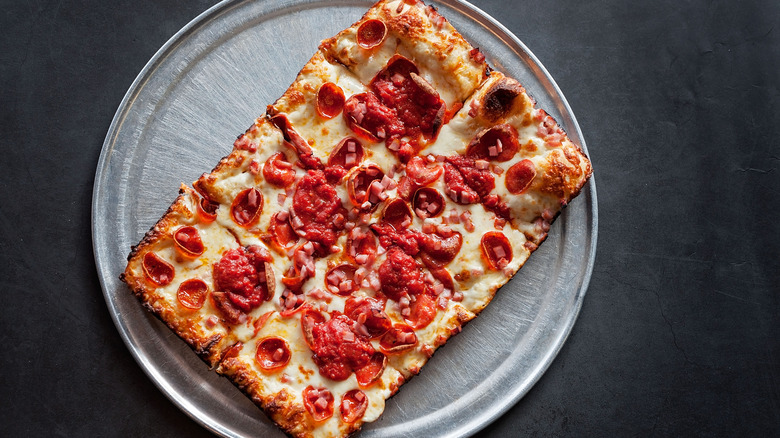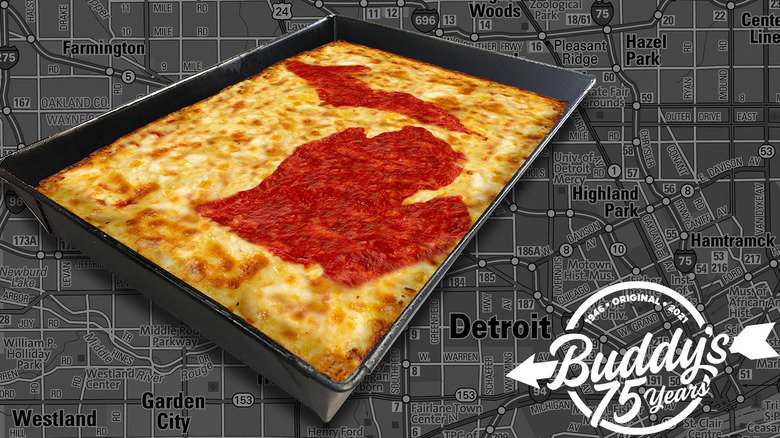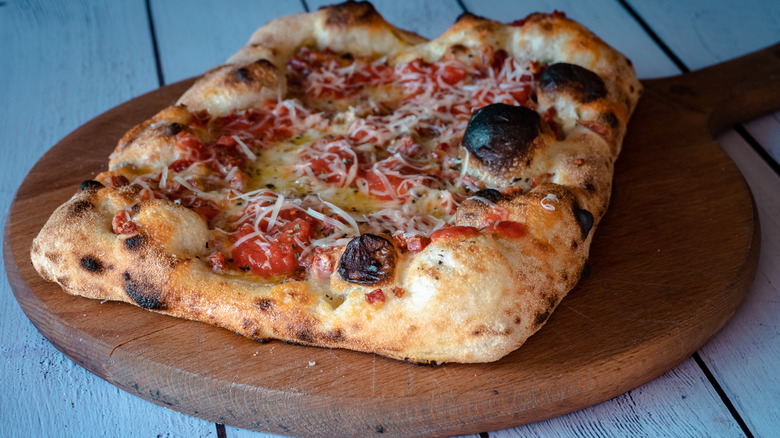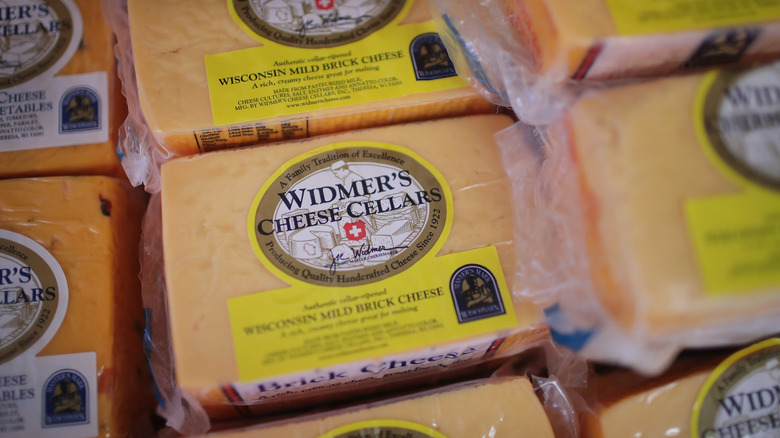The Untold Truth Of Detroit-Style Pizza
New York, Chicago, Detroit — all three are some of the most well-known cities in the US that just so happen to be engaged in a contentious debate that has every citizen, young and old, from all walks of life, in the fray to declare that their city is the better choice. But what could be so important that these three major metropolises are trying to seek victory over the other?
If you said pizza, then you are correct!
Though we're not here to try and solve the age-old debate of which city has the best (we have plenty of love for all three!) — instead, we're here to shed some light on one of the lesser known takes on the classic Italian dish of dough, tomato, and cheese — or at least the one that gets far less attention. That being Detroit-style pizza.
No matter if you're a Michigan-born native or just a tourist that happened upon a Buddy's Pizza while on vacation and fell in love with the dish, we're here to give you a slice or two of knowledge about this hometown favorite.
Detroit-style pizza can be traced to one man
The year is 1946. In the sweltering kitchen of a Detroit restaurant and bar, Buddy's Rendezvous, Gus Guerra wipes the sweat from his brow as he kneads pizza dough into a rectangular blue steel tray he picked up from the garage of a car dealer down the block. He presses the dough into all the corners until it's in a firm rectangle shape — the same style that Sicilian engineers used to lay stones to build their streets. Guerra then carefully shingles a base of pepperoni along the dough, followed by a blanketing of melty Wisconsin brick cheese and a slather of smooth red tomato sauce that covers the top and can flow over the soon-to-be golden brown caramelized cheese.
Michigan.org and Thrillist both point to Gus' restaurant, Buddy's, as the point of origin where Detroit-style pizza was born. Although it's debated if Gus received the traditional Sicilian recipe that would become the famous dish from his wife Anna or an employee by the name of Connie Piccinato, it is a fact that Buddy's Pizza has been hailed as the godfather of this style and has in due time become a popular Michigan-based chain — also named one of the five best pizzerias in the United States by the Food Network, per Pizza Marketplace.
If you're ever in Michigan, Buddy's is still there for a slice of pizza history.
What's the difference between Detroit-style and Sicilian pizza?
Here's the real question: Just what makes Detroit-style any different from the similar-looking Sicilian pizza? After all, since ol' Gus Guerra apparently started with a Sicilian recipe, is it just a normal Sicilian pizza under a different guise?
Detroit-style pizza may have gotten its influence from Sicily, but it gets its roots from Sfincione, says Home Cook World, a style also known as "grandma pizza," which consists of a flat focaccia-like dough that's topped with tomato sauce, onions, anchovies, and Caciocavallo cheese, and then finished with a thick layer of bread crumbs. Over time, as Italians immigrated to the US, Sfinicione-style pizza changed, using American cheese and sliced pepperoni.
While it does sound a lot like Detroit-style, its difference lies within how it is baked — Detroit-style is cooked in an anodized aluminum pan at 550 degrees Fahrenheit, while "grandma pie" is baked on a sheet pan at 450 degrees Fahrenheit — as well as Detroit's usage of Wisconsin cheese instead of normal mozzarella.
It is clear that these two styles of pie are both equal in some respects, and different in others. And American foods in general have taken inspiration from other cultures, just like pretzels, doughnuts, and all other things that were brought to this country and made by immigrants.
You can eat Detroit-style pizza with a fork and knife
Anyone that's ever had a good piece of pizza knows there's nothing better than picking up the light, crunchy crust of a New York-style slice with nothing but their God-given hands and taking a big cheesy bite. To use a fork and knife to eat pizza would seem laughable — like a child incapable of feeding themselves and, at the same time, making a mockery of a beloved dish. In Detroit, however, you are forgiven if you use some silverware to cut into your piece of the pizza.
Via PMQ, that's because Detroit-style pizza is served at a not-so-cool 230 degrees Fahrenheit, so perhaps plunging you fingers into it immediately maybe isn't the best option. It's a safer bet to cut into it with a knife and fork to let allow that porous airy crust a bit more time to cool. The sheer thickness of the crust is another issue. Like Gus Guerra who first used a factory pan to make this pie, this style continues to be baked in a pan made of a "thick steel ... more similar to a cast iron skillet than a cake pan," says Michigan.com. So, a slice of this pizza is not as simple to pick up as its thinner New York cousin.
Though, if you're willing to forsake the fork and knife and show the world how tough you can be, go ahead and rip it into that pizza bare-handed. No one's judging.
This pizza is very particular when it comes to cheese
As mentioned above, it's not just about the pan that makes Detroit-style pizza so special. It's also specifically made with another Midwest specialty: Wisconsin brick cheese. While most know that Wisconsin is renowned for its cheeses, this one stands out.
According to WisconsinCheese.com, this type was invented in the late 1800s and has recently begun to grow more in popularity. It's more than just a literal brick of cheese — which you can find a plenty at the grocery store — but rather it's actually a style, like gouda or brie or mozzarella, and the name comes from the bricks that cheesemakers use to press the curds together.
This style comes in two forms, one a buttery, high-fat semisoft cheese and the other, a more aged and pungent cheese. The former is desired for making Detroit-style pizza where the light, Focaccia-like crust mingles with this easy-melting cheese, allowing that perfectly golden bubbly crust on top to be slathered in racing stripes of robust sauce.
The big win at the International Pizza Expo
Much like Rocky overcoming all odds in the famous titular film, this Rust Belt-born pizza pie surprised everyone by winning the International Pizza Expo World Championship in 2012 (as seen on YouTube). The chef preparing it for the competition was local culinary star Shawn Randazzo, then behind metro Cloverleaf Pizza Carryout and Delivery (per a press release), whose "humble" entry immediately catapulted him into the Pizza Hall of Fame.
In fact, the reaction to Randazzo's victory was so great that, according to pizza educator Tony Gemignani, industry names were making calls demanding a "recipe for Detroit."
Randazzo, most recently owner of a place called Detroit-Style Pizza Company, became so sought-after that he began a training and certification program on creating authentic Detroit-style pizza, with 36 restaurateurs trained in the US, Thailand, and South Korea by 2018. There's even a website created by Randazzo, which offers training classes, specialty equipment such as steel pizza pans and dough mix, and the ability to order Detroit goodness from anywhere in the world.
While unfortunately Randazzo died in December 2020 of brain cancer, according to the Detroit Free Press, his memory still lives on in his legacy and the legacy of the pizza he worked so hard to make a household name.
Pizza Hut tried getting in the Detroit-style game
With the growing popularity for Detroit-style pizza, national chain Pizza Hut recently launched its own spin on the Detroit classic in January, according to their website. Boasting everything from the mandatory caramelized edges of cheese on the rectangular corners to an exclusive vine-ripened tomato sauce spread atop of the pie, Pizza Hut reportedly tried 500 iterations during a testing phase just to land the winner. The 'Hut sells four variations of the classic Detroit-style pizza: the Double Pepperoni, Double Cheesy, Meaty Deluxe, and the Supremo, each with their own unique toppings.
The Washington Post's review on Pizza Hut's Michigan-inspired dish was less than positive. The paper had a native Michiganer try the pizza for himself who is quoted as saying, "It looks like a Detroit pizza — all the cornerstone elements are represented. But they're all a little off, so when you put them all together it ends up entirely different." The reviewer also claims that "anyone who grew up in Detroit would probably be offended."
Yet, The Takeout's Dennis Lee had a different opinion, hailing the Detroit-Style pizza as "one of the best things Pizza Hut has made in years," giving high praise to the crust and cheese, but noting the overly acidic taste of the sauce.
Lee did make note, however, that Jet's Pizzeria's deep-dish is "still safe for now" and is a great example of the style.
Perhaps it doesn't matter what sort of pizza is better, or where it came from, but perhaps it matters more that it's something that we, as Americans no matter where we come from, can all truly enjoy it together.






